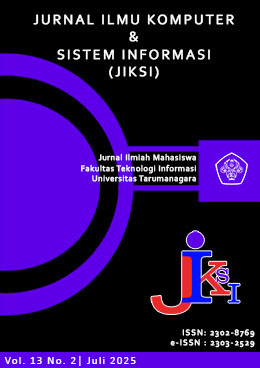PREDIKSI KEBANGKRUTAN PERUSAHAAN MENGGUNAKAN DECISION TREE, RANDOM FOREST DAN LOGISTIC REGRESSION: ANALISIS RASIO KEUANGAN SEBAGAI INDIKATOR RASIO
Main Article Content
Abstract
Tujuan dari penelitian ini adalah untuk menggunakan tiga algoritma klasifikasi: Decision Tree, Random Forest, dan Logistic Regression untuk memprediksi kebangkrutan perusahaan. Sebagai indikator utama untuk mengukur risiko kebangkrutan perusahaan, penelitian ini menggunakan data rasio keuangan yang terdiri dari berbagai rasio keuangan, termasuk return on assets (ROA), margin laba operasi, dan total turnover aset. Penelitian menilai model yang dibangun menggunakan metrik performa seperti akurasi, ketepatan, recall, dan skor F1. Hasilnya menunjukkan bahwa model Logistic Regression memiliki tingkat akurasi tertinggi sebesar 96%. Penelitian ini memberikan wawasan tentang efektivitas rasio keuangan dalam memprediksi kebangkrutan dan relevansi penggunaan berbagai algoritma klasifikasi keuangan.
Article Details

This work is licensed under a Creative Commons Attribution-NonCommercial-ShareAlike 4.0 International License.
This work is licensed under a Jurnal Komunikasi Creative Commons Attribution-ShareAlike 4.0 International License.
References
A. Altman, "Financial ratios, discriminant analysis and the prediction of corporate bankruptcy," The Journal of Finance, vol. XXIII, no. 4, pp. 589-609, 2018.
[2] B.Jones and C. Smith, "Machine learning models for bankruptcy prediction: A systematic review," Journal of Financial Risk Management, vol. XLV, no. 3, pp. 103-118, 2019.
[3] C. Z. Li and X. W. M. Qiu, "Predicting corporate bankruptcy: A comparison of traditional models and modern machine learning algorithms," Finance and Data Science, vol. XII, no. 3, pp. 67-79, 2020.
[4] E. L. D. Lin, "Financial ratios and the prediction of corporate failure: A reassessment," Accounting Review, vol. XCI, no. 2, pp. 567-590, 2021.
[5] E. Z. Tan and H. J. Yang, "A comparative analysis of machine learning algorithms in predicting corporate bankruptcy," AI & Finance, vol. XIV, no. 3, pp. 233-245, 2022.
[6] F. Russo, "The role of financial ratios and machine learning in bankruptcy prediction," Journal of Applied Economics, vol. XXXVIII, no. 4, pp. 418-432, 2021.
[7] G. Clark, M. Fisher and J. Wang, "Machine learning and financial health predictions: Recent advances," Journal of Applied Finance, vol. XL, no. 2, pp. 201-215, 2023.
[8] T. K. Lee, "Machine Learning Approaches for Bankruptcy Prediction: A Comparative Study," IEEE Access, vol. VIII, no. 8, pp. 165943-165953, 2020.
[9] M. P. C. Leal, "Using Machine Learning for Financial Distress Prediction," Applied Sciences, vol. XI, no. 2, p. 771, 2021.
[10] A. Gupta and S. Kumar, "A Review of Predictive Models for Bankruptcy Prediction," International Journal of Financial Studies, vol. IX, no. 3, p. 33, 2021.
[11 J. M. Hwang and S. J. Lee, "Data Mining Techniques for Bankruptcy Prediction," Information Sciences, vol. DLXXVI, pp. 153-163, 2021.
[12] R. S. Sahu and D. K. Gupta, "Financial Distress Prediction Using Machine Learning Techniques," Journal of Risk and Financial Management, vol. XIV, no. 7, p. 335, 2021.
[13] M. H. Afshari, "Understanding the Role of Financial Ratios in Predicting Bankruptcy," International Journal of Economics and Financial Issues, vol. XI, no. 2, pp. 80-89, 2021.
[14] R. Mahesh and A. D. Desai, "Prediction of Bankruptcy Using Financial Ratios and Machine Learning," Journal of Business Research, pp. 144-155, 2021.
[15] E. C. Yi, "A Study on the Efficiency of Machine Learning Techniques for Bankruptcy Prediction," Expert Systems with Applications, p. 115471, 2021.
[16] B. S. A. Kharin and E. V. Shapovalova, "lgorithms of Financial Analysis and Bankruptcy Prediction," International Journal of Open Information Technologies, vol. VIII, no. 2, pp. 56-63, 2021.
[17] K. S. Kumari and M. G. Manikandan, "Role of Machine Learning in Financial Distress Prediction," International Journal of Engineering Research and Technology, vol. X, no. 6, pp. 101-108, 2021.
[18] N. T. Almansoori, "Evaluation of Machine Learning Models in Predicting Financial Distress," Computers in Human Behavior, vol. CXXX, p. 107149, 2022.
[19] A. I. D. Naeem and B. R. Choudhury, "Model Evaluation Metrics for Bankruptcy Prediction Models," Journal of Data Science, vol. XX, no. 1, pp. 23-35, 2022.
[20] K. G. V. Shrestha, "Predictive Models for Bankruptcy: A Machine Learning Approach," Computational Economics, no. 2, pp. 245-265, 2022.
[21] L. M. Huang and J. Wang, "Decision Trees for Bankruptcy Prediction: A Comparative Study," Information Sciences, pp. 1-15, 2022.
[22] J. H. Chen and H. Zhang, "Random Forest for Bankruptcy Prediction: Insights and Analysis," Journal of Financial Stability, 2022.
[23] F. X. Silva and S. Pereira, "Random Forest-Based Methods for Predicting Bankruptcy," Business Research, pp. 65-77, 2023.
[24] P. M. Fernandes, "Logistic Regression in Financial Distress Prediction," Journal of Financial Risk Management, vol. XI, no. 1, pp. 109-121, 2023.
[25] T. P. Ryner and C. A. Valle, "Bankruptcy Prediction Using Logistic Regression: An Empirical Approach," Finance Research Letters, 2023.
[26] N. Jones and K. T. He, "ROC Curves and Model Evaluation for Bankruptcy Prediction Models," European Journal of Operational Research, pp. 511-522, 2023.
[27] Y. A. Lau and S. T. Lee, "Evaluation of Model Performance in Financial Risk Prediction," International Journal of Financial Studies, pp. 88-99, 2023.
[28] J. M. Kim and K. Park, "A Comparative Analysis of Machine Learning Models for Bankruptcy Prediction," Artificial Intelligence Review, pp. 1937-1951, 2023.
[29] H. D. Nguyen, "Evaluating the Efficiency of Machine Learning Models in Bankruptcy Prediction," Journal of Applied Finance, pp. 79-94, 2023.



